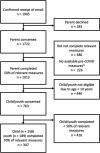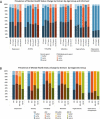Mostly worse, occasionally better: impact of COVID-19 pandemic on the mental health of Canadian children and adolescents
- PMID: 33638005
- PMCID: PMC7909377
- DOI: 10.1007/s00787-021-01744-3
Mostly worse, occasionally better: impact of COVID-19 pandemic on the mental health of Canadian children and adolescents
Abstract
This large cross-sectional study examined the impact of COVID-19 emergency measures on child/adolescent mental health for children/adolescents with and without pre-existing psychiatric diagnoses. Using adapted measures from the CRISIS questionnaire, parents of children aged 6-18 (N = 1013; 56% male; 62% pre-existing psychiatric diagnosis) and self-reporting children/adolescents aged 10-18 (N = 385) indicated changes in mental health across six domains: depression, anxiety, irritability, attention, hyperactivity, and obsessions/compulsions. Changes in anxiety, irritability, and hyperactivity were calculated for children aged 2-5 years using the Strengths and Difficulties Questionnaire. COVID-19 exposure, compliance with emergency measures, COVID-19 economic concerns, and stress from social isolation were measured with the CRISIS questionnaire. Prevalence of change in mental health status was estimated for each domain; multinomial logistic regression was used to determine variables associated with mental health status change in each domain. Depending on the age group, 67-70% of children/adolescents experienced deterioration in at least one mental health domain; however, 19-31% of children/adolescents experienced improvement in at least one domain. Children/adolescents without and with psychiatric diagnoses tended to experience deterioration during the first wave of COVID-19. Rates of deterioration were higher in those with a pre-exiting diagnosis. The rate of deterioration was variable across different age groups and pre-existing psychiatric diagnostic groups: depression 37-56%, anxiety 31-50%, irritability 40-66%, attention 40-56%, hyperactivity 23-56%, obsessions/compulsions 13-30%. Greater stress from social isolation was associated with deterioration in all mental health domains (all ORs 11.12-55.24). The impact of pre-existing psychiatric diagnosis was heterogenous, associated with deterioration in depression, irritability, hyperactivity, obsession/compulsions for some children (ORs 1.96-2.23) but also with improvement in depression, anxiety, and irritability for other children (ORs 2.13-3.12). Economic concerns were associated with improvement in anxiety, attention, and obsessions/compulsions (ORs 3.97-5.57). Children/adolescents with and without pre-existing psychiatric diagnoses reported deterioration. Deterioration was associated with increased stress from social isolation. Enhancing social interactions for children/adolescents will be an important mitigation strategy for current and future COVID-19 waves.
Keywords: COVID-19; Child and adolescent psychiatry; Neurodevelopmental disorders.
© 2021. Springer-Verlag GmbH, DE part of Springer Nature.
Conflict of interest statement
The authors declare no commercial conflicts of interest.
Figures


References
-
- Bridley A, Jordan SS. Child routines moderate daily hassles and children's psychological adjustment. Children's Health Care. 2012;41(2):129–144. doi: 10.1080/02739615.2012.657040. - DOI
MeSH terms
LinkOut - more resources
Full Text Sources
Other Literature Sources
Medical

